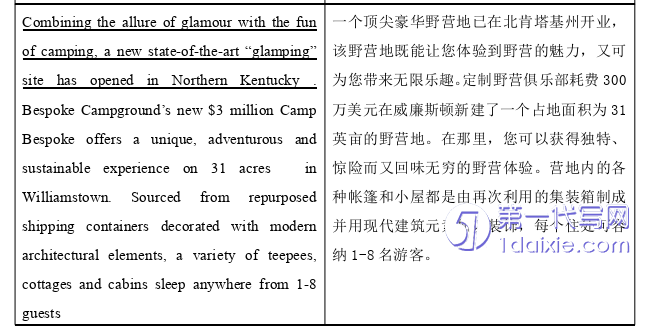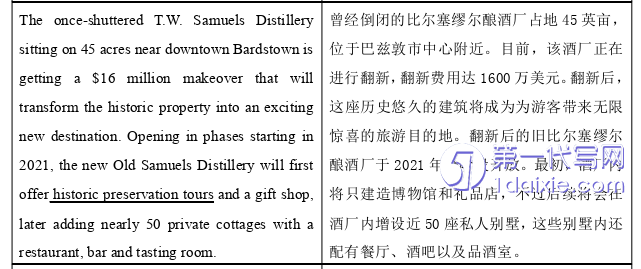本文是一篇英语论文,本文是一篇基于《2021肯塔基州官方游客指南》的英汉翻译实践报告,源文本于2021年由肯塔基州旅游局发布。《2021肯塔基州官方游客指南》描述了肯塔基州的自然风光、人文古迹、特色产物和民俗传统,文化信息丰富。笔者选取该指南中的部分内容作为翻译材料。
Chapter One Task Description
1.1 Background of the Translation Task
Over the years,the friendship between different countries around the world hasbeen deepening.In such an international environment,tourism gains momentumworldwide,and people all over the world choose to travel around the world onholidays to relax and have fun.When people travel to a strange country with itsunique culture,tourist brochures written in different languages have just become animportant way for them to understand and choose tourist destinations,then thetranslation of travel brochures appeared as needed,which is very important forpeople’s trip.
However,due to differences between China and the west in culture and way ofthinking,the translation quality of foreign and domestic tourism materials in Chinais not very good.The current translation of those tourism materials is filled with allkinds of mistakes in spelling,word collocation,grammar and so on.Thesepoor-translated versions of tourism materials will cause a bad effect on the publicityof the scenic spots of China and impede the exchange of traditional cultures ofdifficult countries.
1.2 Translation Process
The whole translation process goes through three stages,namely,pre-translation,while-translation and post-translation.
1.2.1 Pre-translation
Pre-task preparation is very important and essential.To achieve accurate,professional and natural translation,the translator made sufficient preparationsbefore translation.
Firstly,reading the source text.In order to have a better understanding of thesource text and lay a solid foundation for the following translation,the translatorread the source text many times to learn about its main content,then carefullyanalyzed its several major features.
Secondly,learning background information.This visitor’s guide focuses onintroducing Kentucky,America.After reading through the entire text,the translatorlooked for information about the attractions introduced in the source text on theInternet in order to have a general understanding of these attractions beforetranslation.Then the translator looked at some books and websites about Kentuckyand the tourism industry of Kentucky to get a more comprehensive understanding ofKentucky and make the translation go smoothly.
Third,collecting and reading parallel texts.In order to translate the source textinto Chinese concisely and faithfully,it is imperative for the translator to refer to lotsof parallel texts.The translation material of this practice is the official Kentucky visitor’s guide,a tourism text.So the translator searched and read a large number ofpapers about that E-C or C-E visitor’s guides,as well as the Chinese and Englishversions of the introduction of some attractions in Kentucky through the Internet.Inthe process of collecting and reading these materials,the translator learned moreabout the source text and grasped the language styles and textual features of thetourism text,which laid a good foundation for the translation.
Chapter Two Source Text Analysis
2.1 Contents of the Source Text
The source text is selected from the Official Kentucky Visitor’s Guide 2021,which is a visitor’s guide published by the Kentucky Department of Tourism.Atpresent,there is no official Chinese version.This visitor’s guide tells people howbeautiful and great Kentucky is by introducing its scenic spots,ancient and moderncultural activities,and delicious food and drinks,attracting domestic and foreigntourists.The visitor’s guide includes several chapters.The first chapter introducesthe basic condition of Kentucky.The following parts introduce different scenic spotsincluding their location,scenery and delicious food.

2.2 Features of the Source Text
It is essential to learn about the features of the source text and then adopt theappropriate strategies to make the translation better.
At the lexical level,lots of nominalizations,descriptive adjectives,andculture-loaded words are used in the source text.
(1)Culture-loaded words
Bao Huinan(2004:10)proposed that culture-loaded words are words carryingcultural information from the source text.As a visitor’s guide of Kentucky,America,the source text contains many culture-loaded words.There are some sourcesentences.
See how the Shakers lived and where Loretta Lynn became a legend.
Home of the notorious Hatfield-McCoy Feud,Pikeville is nestled in the greenhills of Eastern Kentucky.
The two examples are about two ancient historical events.Shakers belong to anAmerican religious sect.While the Hatfield-McCoy Feud refers to a conflictbetween two clans during 1863-1891,now this word has become a folkloric word.
Chapter Three Case Analysis.......................................10
3.1 Translation of Culture-Loaded Words................................10
3.1.1 Literal Translation with Annotation.................................10
3.1.2 Free Translation...............................11
Conclusion............................25
Chapter Three Case Analysis
3.1 Translation of Culture-Loaded Words

Each nation owns its unique culture,while a kind of culture would create itswords.Against this background,a large number of culture-loaded words appear inthis foreign visitor’s guide.Culture-loaded words refer to words that expressparticular things in a certain culture(Liao,2000:232).Each country owns its uniqueculture,and the source text written in English contains a lot of cultural informationabout Kentucky,such as names of historical figures and historical events,which maybe familiar to Westerners,but are strange to Chinese.Consequently,it is necessary tosupply certain knowledge that is not available to target readers.During thetranslation,the translator adopted literal translation with annotation and freetranslation to faithfully and naturally express the real meaning of the source content,but also supplied some cultural background to remove reading barriers for targetlanguage readers.
3.1.1 Literal Translation with Annotation
Literal translation with annotation refers to a translation skill making necessaryexplanations for the translation.The source text may involve cultural phenomena,national features or local characteristics.As two entirely different languages,Englishand Chinese have their words owning their unique cultural connotations.In order tofully reproduce the cultural connotations contained in the source text,literaltranslation with explanation is generally adopted to avoid reading barriers for targetlanguage readers.
Conclusion
This report,based on the translation of The Official Kentucky Visitor’s Guide2021,expatiated the difficulty points in the translation.Then on the basis of previousstudies,the translator analyzed specific cases and summarized strategies to solvethese difficulty points.
The translator got a lot of benefits when translating this material and writingthis report.First,the translator gained some translation experience.In order to get ahigh-quality translation with authentic Chinese expressions,the translator made atranslation plan and implemented it strictly.After the process,the translator gatheredmuch practical experience in tourism translation.Moreover,the translator’sknowledge of tourism texts has been expanded.As the source text is a visitor’s guide,which is a tourism text,the translator read a large number of works and papers abouttourism at home and abroad,gaining much professional knowledge about tourism infinishing the translation practice.
Of course,owing to the translator’s deficiency of professional knowledge andability,there are still shortages of this paper.First,because of the limited ability andknowledge,the translator didn’t finish the translation and write the paper as planned.Second,since the translator has limited translation experience,the analysis of thedifficult points is not profound and complete.Third,because the translator grow upin China and couldn’t transfer thinking models when translating,the translator doesnot greatly understand what some sentences want to express,so the translation ofsome sentences in the source text needs to be improved.
reference(omitted)
